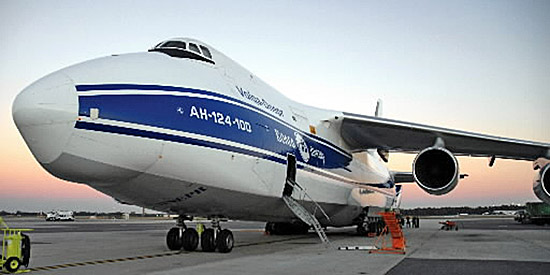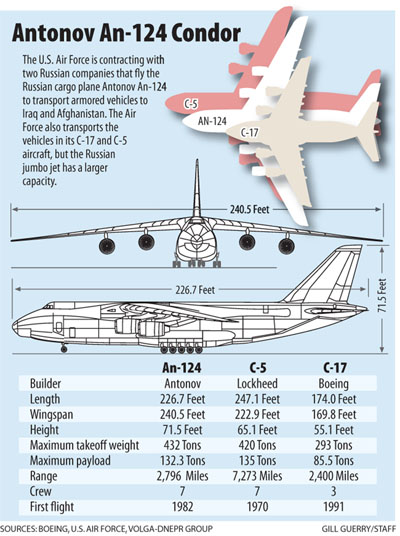
AIR FORCE HIRES RUSSIAN JETS
By Ron Menchaca
The Post and Courier
Saturday, January 5, 2008

Airman 1st Class Sam Hymas/U.S. Air Force
The Russian-made Antonov An-124 is a behemoth aircraft capable of
transporting twice as many of the largest style of armored
vehicles - four as opposed to two - as the U.S. Air Force's C-17.
The Charleston Air Force Base is synonymous with its C-17 cargo
planes, the mammoth military workhorses of the Lowcountry skies. But
demand for armored vehicles in the wars in Iraq and Afghanistan have
brought a new plane to town, and forced the U.S. Air Force to rely on
an unlikely partner to help transport the trucks to the war zones: Cold War
enemy
Russia.
The Department of Defense is contracting with
two Russian-based companies that operate fleets of Russian-made cargo
planes to move the desperately needed, mine-resistant vehicles to
troops overseas.
That's because in addition to the Air Force's C-17 and its largest cargo plane, the
C-5, the Russian-made An-124 is the only other aircraft in the world with enough room
and lift to haul the massive armored trucks.
The Antonov An-124 Condor is the largest commercially available aircraft in the
world, with a 240-foot wingspan and lift capability of 120 metric tons.
Roadside bomb attacks targeting American and coalition troops in Iraq and Afghanistan
accelerated demand for the lifesaving armored vehicles in recent years. The
trucks, known in military jargon as Mine-Resistant Ambush-Protected vehicles, or
MRAPs.
The An-124 can carry four of the largest style of armored vehicle, twice as
many as the C-17 can hold. Each vehicle weighs about 38,000 pounds.
To meet the need, the U.S. military began a $300 million, six-month contract in
October with Volga-Dnepr, a Russian company with a U.S. office in Houston. The
company uses Russian crews, including pilots.
Another smaller Russian-based company, Polet Cargo Airlines, also is supplying
An-124s for the missions. Both companies are subcontracted through American-flag
carriers Atlas Air and Lynden Air Cargo as part of the military's Civil Reserve
Airlift Fleet.
"Most Americans would be shocked to know this fact," said MacKenzie Eaglen, a senior
policy analyst with Heritage Foundation, a Washington think-tank. "It shows the
challenges facing the Air Force."
The U.S. military routinely contracts with civilian airline and maritime
companies to move troops and equipment overseas. Volga-Dnepr has moved U.S. military
cargo for years, according to the company.
Charleston Air Force Base officials referred questions about the Russian
aircraft to the U.S. Transportation Command at Scott Air Force Base in Illinois.
Army Lt. Col. Frederick Rice, the command's public affairs officer, said the contract
does not mean that the military lacks the ability to do the job with its own
aircraft. He said the Russian aircraft frees C-17s and C-5s to fly other missions.
"As we continue on a daily basis to support operations, we still want to move troops,
bullets and beans,"
Rice
said.
He said early demand for armored vehicles was so great that the Air Force opted to
transport the cargo by air, a faster but more costly method. As demand has
stabilized, the military also has started shipping the trucks by sea. Last month, a
military-chartered ship left Charleston for Iraq carrying 240 of the armored
vehicles, a voyage that took nearly a month.
Eaglen said the use of Russian aircraft highlights the Air Force's budget challenges
as it continues to fly war missions with an aging fleet of aircraft. "They are flying
more, longer and harder flights and face a $20 billion shortfall for modernization."
The Air Force owns 111 C-5s and 171 C-17s, including about 50 assigned to the
Charleston Air Force Base. But the C-17s are spread thin with constant missions, and
the C-5 fleet is in dire need of technological upgrades, military analysts have said.
Air Force Secretary Michael Wynne told the House Armed Services Committee in October
that relying on the Russian jumbo jets to move war supplies indicates that the Air
Force might need more C-5s and C-17s.
"We are now sharing the mission of flying (armored vehicles) over to Iraq between
C-17s and Antonov airplanes," Wynne said, according to a report in the Air Force
Times. "Did [we] truly envision that we would fly war supplies with Russian-made
airplanes? I don't know."
Complicating matters, Boeing, the maker of the C-17, announced in August that it
would cease production of the plane in 2009 unless the Air Force orders more planes.
The company has manufactured about 180 C-17s for the Air Force. Rice said there are
commitments in place to grow the C-17 fleet to 190. Beyond that, it's up to Congress,
which is debating whether to continue funding enough C-17s to keep production afloat.
Ron King, commercial director for Volga-Dnepr in Houston, said his company is happy
to fill the void.
The company has a fleet of 10 An-124s out of about 22 in commercial operation
worldwide. The Soviet-built Antonov debuted in 1982. It was first made for the
Russian Air Force, which still maintains a fleet. After the collapse of the Soviet
Union, private investors bought up dozens of the aircraft. Since then the jumbo jets
have been in heavy demand for oversized cargo jobs around the world.
Volga-Dnepr began offering its charter services in the United States in 2000. The
company's An-124s have moved a wide variety of items -- towering Christmas trees,
rocket boosters, offshore oil rigs and space satellites.
"If it's big and ugly, we have moved it," King said. "At this point, we could double
our fleet and keep them busy."
The contract for the Russian Antonovs runs through March. From a cargo standpoint,
the armored vehicles moving out of Charleston are unremarkable, King said.
"It's just another job, very straightforward as far as we are concerned,"
King said.

Copyright © 1997-2007 the Evening Post Publishing Co.